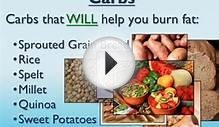
Oh, lasagna. Is there a mother alive who hasn't eaten it during her baby's first few weeks of life? And sometimes for breakfast, lunch and dinner? The early days at home with a newborn are a blurry whirlwind, and those comfort-food casseroles brought by family and friends may be the only solid meals you get. But eventually there comes a time when you know you're ready to eat something that's not baked in cheese, and you start to think about finally getting out of your maternity clothes.
Even though your prepregnancy body may seem like a distant memory, the notion that women "never lose the baby weight" just isn't true: According to nutrition researcher Christine Olson, Ph.D., of Cornell University, in Ithaca, New York, the average amount of extra weight that women retain within a year of giving birth is a measly three pounds. Of course, if you gained more than the standard 25 to 35 pounds, you may find the going a bit tougher, Olson's research shows.
The challenge is, you're a new mom—you don't have time for complicated calorie counting or restrictive wheatgrass-and-soy menus. If you've been following our plan the past two issues, you deserve a big shout-out for reaching some mega mommy milestones: You're exercising and feeling good about yourself. Now it's time to tackle the kitchen! Here are the rules:
1. You need to eat. There's no need to go crazy counting calories—just stick to appropriate serving sizes and you'll be on your way. If you really want a benchmark, aim for 1, 800 to 2, 000 calories daily if you don't exercise, and up to 2, 400 if you do, says Elisa Zied, R.D., New York City author of Feed Your Family Right. If you're breastfeeding exclusively, you can add another 500 calories to your daily intake.
2. Focus on your hunger cues. Pay attention to how you feel: On a scale of one to ten, if one is "haven't-eaten-in-days starving" and ten is "stuffed like a Thanksgiving turkey, " aim to be around a four when you start a meal and a six when you finish.
3. Watch the clock. Eat something about every three or four hours to keep your blood-sugar and energy levels steady throughout the day.
4. Go slow. Plan to lose only one or two pounds a week, especially if you're breastfeeding. Losing weight too quickly can impact your milk supply.
Your Healthy-Eating Checklist
Here's a simple, low-effort way to get the nutrients you need: Print out our list below, then make check marks next to each food group as you go through your day. By focusing on the good-for-you foods you should be eating, you'll have "less room" for the junky stuff. (And be sure to add in a favorite treat a few times a week to satisfy your cravings!)
How will you fit all of these foods in each day? Follow this easy rule from Melinda Johnson, R.D., a spokesperson for the American Dietetic Association in Chandler, Arizona, and owner of Nutrition for Slackers, LLC: "At every meal, make sure to include three food groups. For every snack, include two food groups." Eat these foods every day:
Fruit
(at least 3 servings) One serving equals 1 medium whole fruit or 1/2 cup (a generous handful) of cut-up fruit (or juice)
Veggies
(at least 4 servings) One serving equals 1 cup leafy greens or 1/2 cup (a generous handful) of cut-up raw or cooked veggies
Dairy
(at least 3 servings) One serving equals 1 cup milk or yogurt or 1 1/2 ounces cheese (about the size of your thumb)
Whole Grains
(at least 4 servings) One serving equals 1 slice bread or 1/3 cup grains (a palm-size handful)
Lean Protein
(at least 3 servings) One serving equals 1 ounce of nuts (a small handful), 2 tablespoons peanut butter (golf-ball size), a 4-ounce (palm-size) portion of meat or fish, or 1/2 cup beans (a generous handful)
Treat
(1 serving of a favorite food every two or three days) Check nutrition labels for serving sizes
Got ten minutes? Plan a week's worth of meals!
This genius meal-planning tool from Jackie Keller, Los Angeles author of Body After Baby, will help you figure out what to eat. First, draw a grid. In the horizontal slots, write the days of the week. At the top of the vertical slots, list your meals: "breakfast, " "snack, " "lunch, " "snack, " and "dinner." Then plug in your choices from our list below. Your grid is now a meal plan and shopping list!
Sunday:
Breakfast: sausage sandwich, juice
Snack: graham crackers and peanut butter
Lunch: wrap sandwich
Snack: hummus and veggies
Dinner: salad with shredded chicken
Monday:
Breakfast: cereal with skim milk and fruit
Snack: trail mix
Lunch: pasta with beans and veggies
Snack: graham crackers and peanut butter
Dinner: McDonald's salad and parfait
Tuesday:
Breakfast: peanut butter and banana sandwich
Snack: string cheese and apple
Lunch: salad with shredded chicken
Snack: hummus and veggies
Dinner: rice and beans with vegetables
Wednesday:
Breakfast: cereal with skim milk and fruit
Snack: fruit smoothie
Lunch: wrap sandwich
Snack: trail mix
Dinner: frozen entree
Thursday:
Breakfast: hard-boiled egg, toast, grapefruit
Snack: string cheese and apple
Lunch: pasta with beans and veggies
INTERESTING VIDEO












